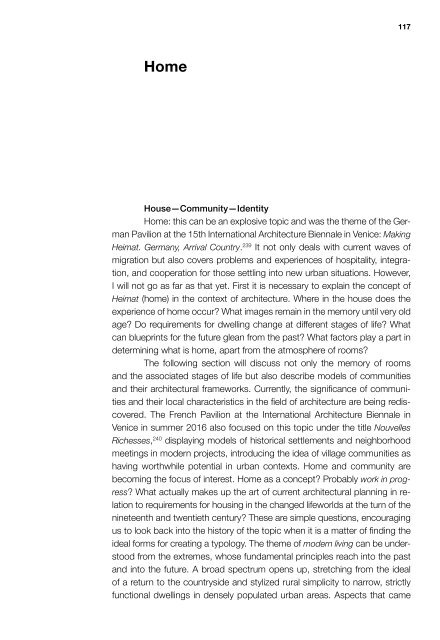Neuroarchitecture
978-3-86859-479-9 https://www.jovis.de/de/buecher/product/neuroarchitecture.html
978-3-86859-479-9
https://www.jovis.de/de/buecher/product/neuroarchitecture.html
Create successful ePaper yourself
Turn your PDF publications into a flip-book with our unique Google optimized e-Paper software.
117<br />
Home<br />
House—Community—Identity<br />
Home: this can be an explosive topic and was the theme of the German<br />
Pavilion at the 15th International Architecture Biennale in Venice: Making<br />
Heimat. Germany, Arrival Country. 239 It not only deals with current waves of<br />
migration but also covers problems and experiences of hospitality, integration,<br />
and cooperation for those settling into new urban situations. However,<br />
I will not go as far as that yet. First it is necessary to explain the concept of<br />
Heimat (home) in the context of architecture. Where in the house does the<br />
experience of home occur? What images remain in the memory until very old<br />
age? Do requirements for dwelling change at different stages of life? What<br />
can blueprints for the future glean from the past? What factors play a part in<br />
determining what is home, apart from the atmosphere of rooms?<br />
The following section will discuss not only the memory of rooms<br />
and the associated stages of life but also describe models of communities<br />
and their architectural frameworks. Currently, the significance of communities<br />
and their local characteristics in the field of architecture are being rediscovered.<br />
The French Pavilion at the International Architecture Biennale in<br />
Venice in summer 2016 also focused on this topic under the title Nouvelles<br />
Richesses, 240 displaying models of historical settlements and neighborhood<br />
meetings in modern projects, introducing the idea of village communities as<br />
having worthwhile potential in urban contexts. Home and community are<br />
becoming the focus of interest. Home as a concept? Probably work in progress?<br />
What actually makes up the art of current architectural planning in relation<br />
to requirements for housing in the changed lifeworlds at the turn of the<br />
nineteenth and twentieth century? These are simple questions, encouraging<br />
us to look back into the history of the topic when it is a matter of finding the<br />
ideal forms for creating a typology. The theme of modern living can be understood<br />
from the extremes, whose fundamental principles reach into the past<br />
and into the future. A broad spectrum opens up, stretching from the ideal<br />
of a return to the countryside and stylized rural simplicity to narrow, strictly<br />
functional dwellings in densely populated urban areas. Aspects that came


















